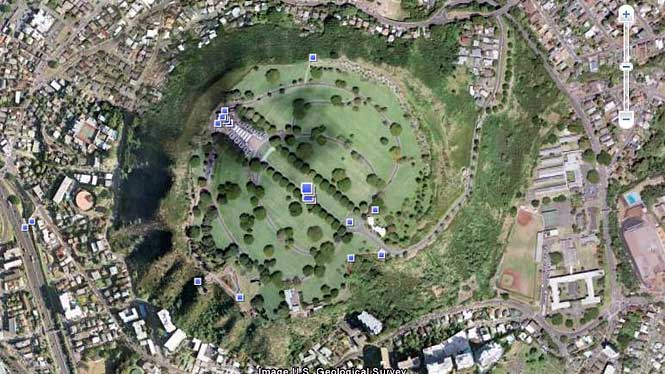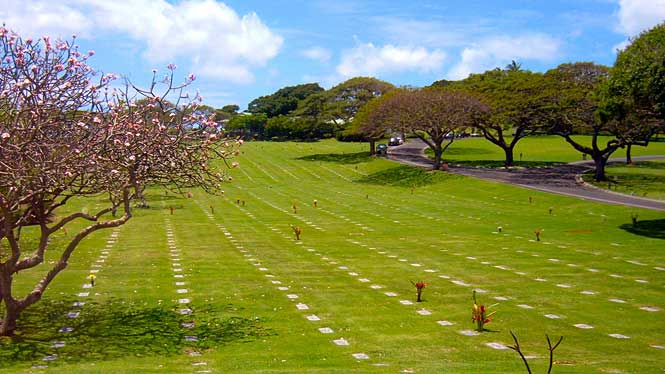Punchbowl Cemetery
Formed some 75,000-100,000 years ago during a period of secondary volcanic activity, Puowaina Crater in Honolulu is today the setting for the National Memorial Cemetery of the Pacific, also known as “Punchbowl.” Among America’s national cemeteries, this is often considered to be the most beautiful and poignant.
The 112-acre cemetery serves as the final resting place for more than 44,200 U.S. war veterans and family members. These include men and women who perished in World War II, the Korean War and the Vietnam War.

The most common translation for Puowaina is “Hill of Sacrifice.” Historians say the first known use of Puowaina was as an altar where early Hawaiians offered human sacrifices to their gods. In the early 1800s, the crater served as a key stronghold for Oahu natives who tried in vain to defend their island from Kamehameha‘s invading army.
Punchbowl’s Purpose
In the early 1940s, the U.S. Congress appropriated funds to establish a small cemetery in Honolulu. In 1943, the governor of Hawaii offered Punchbowl for this purpose. The cemetery finally opened to the public in 1949, with services honoring five war dead, including an unknown serviceman, two Marines, an Army lieutenant, and one civilian. The civilian was famed war correspondent Ernie Pyle, who was killed by a Japanese sniper on an island off the northern coast of Okinawa on April 18, 1945.

Other notable names buried at Punchbowl include Ellison S. Onizuka, Lieutenant Colonel with the U.S. Air Force and the astronaut aboard the ill-fated space shuttle Challenger when it exploded on January 28, 1986.
The cemetery contains a memorial pathway lined with 39 memorials honoring America’s veterans from various organizations. Most of the memorials pay tribute to soldiers of 20th-century wars, including those killed at Pearl Harbor.
The National Memorial Cemetery of the Pacific was placed on the National Register of Historic Places in 1976.
Today
In addition, Punchbowl hosts the Easter Sunrise Service, Honolulu’s oldest ecumenical event. Thousands attend this annual service, which is sponsored by a coalition of churches. The city bus runs a shuttle service from Waikiki to Punchbowl.
Access
The cemetery is located at 2177 Puowaina Drive in Honolulu. Visitor hours are daily, 8 a.m. to 5:30 p.m. (till 6:30 p.m. from March 2 through September 29).
